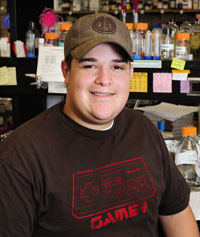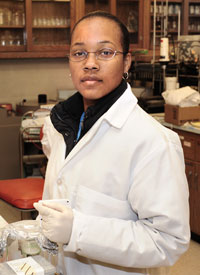Inside Iowa State
Inside ArchivesSubmit newsSend news for Inside to inside@iastate.edu, or call (515) 294-7065. See publication dates, deadlines. About InsideInside Iowa State, a newspaper for faculty and staff, is published by the Office of University Relations. |
July 24, 2008 Summer internships encourage aspiring scientistsby Anne Krapfl Fourteen George Washington Carver interns -- 10 undergraduate and four high school students -- are among the visitors enjoying the Iowa State campus this summer. They come from all over the country, including three this year from Puerto Rico. The interns, aspiring scientists, are partnered with a faculty mentor and join the mentor's summer research team for either six or eight weeks. They work five days a week in the lab, learn how to prepare a research paper and poster and talk about their research, live in Eaton Hall, explore the state together on the weekends and, organizers hope, think about returning to Iowa State. The Carver internship program has been part of the College of Agriculture and Life Sciences' diversity efforts since 1993. In its first 15 summers, 230 students have participated. "Our rate of return so far is about 20 percent," said Mary de Baca, director of diversity for the college. "We think that's worth our investment." The goal of the program is to recruit strong students of diverse racial backgrounds to Iowa State, either as undergraduate or graduate students and, ultimately, to help develop a more diverse scientific community in the country. The Carver internship program is not a race-based program. But de Baca said the marketing of the program largely is to schools that serve minority students, particularly the so-called 1890 schools, separate land-grants established to serve black students; the 31 (American Indian) Tribal colleges, and Hispanic-serving institutions. Meet two Carver interns: Andres Nieves-Perez Andres Nieves-Perez, 17, a home-schooled senior-to-be from San Lorenzo, Puerto Rico, is spending six weeks in microbiologist Larry Halverson's lab in Science I. He's not alone. Halverson's summer research team includes a post-doc, two graduate students and an undergraduate student. Nieves-Perez's work involves growing cultures of a bacterial pathogen found in the lungs of cystic fibrosis patients. It's a fairly harmless bacterium to healthy people. He adds the bacteria to a Jello-like solidizing agent and records their growth. The growth samples vary in the volume of water or salt they contain. Ultimately, Halverson's aim is to try to determine why the bacteria build up in the lungs of cystic fibrosis patients. Nieves-Perez wants to be a veterinarian specializing in large cats and has worked in veterinary clinics. He said lab work, including lab protocol, is new to him. "It's amazing how much I've learned. This is an awesome experience," he said. "I also know that science is what I want." And if there's a little tedium in his assignments, it's worth it. "There's lots of repetition, but it's rewarding when I can say 'Hey, it worked,' and move on in the experiment," Nieves-Perez said. He learned of Iowa State University and the Carver internship program at a university fair in Puerto Rico last November. "I will apply to other schools, but this would be my first choice," he said. 
Shante Mathes Shante Mathes enjoyed her first research experience as a sophomore this year at North Carolina A&T State University, Greensboro. She's studying animal science with an eye on veterinary school. When her department chair alerted her to the Carver summer internship program in January, she began investigating immediately. "I knew that Iowa State is a research-friendly institution, and I learned how strong Dr. (Donald) Beitz's credentials and research background is," she said. "I also wanted to see Iowa State's vet school because next summer I'll have to start applying to vet schools. "I've never been this far from home, and I wanted to try something like this," Mathes added. She was offered a spot on Beitz's summer lab team. The group is starting a new research project studying obesity in mice, with the hope there will be human applications eventually. Specifically, the team is measuring how diet contributes to oxidative stress -- too many toxic molecules in a cell to be balanced by anti-oxidants -- which allows diseases of all kinds to progress. A lot of the work in this field focuses on neurological diseases, but Beitz's research team is looking at obesity. "I love the Carver program because I'm interested in doing lab work," Mathes said. "And I feel comfortable at Iowa State." Already she talks about coming back to campus . . . next summer as a Carver intern again, or perhaps for vet school. |
Collaborative effortThe costs to hire and host the Carver interns is about $6,000 for an undergraduate and $4,000 for a high school intern. This year, about 60 percent of this is shouldered by the College of Agriculture and Life Sciences, but program director Mary de Baca said she's always looking for ways to collaborate with other funders so more students can participate. The largest summer Carver intern class was 39; the average over the 16 years is 18, according to de Baca. She said the colleges of Human Sciences and Veterinary Medicine have been collaborators, as well as units of the U.S. Department of Agriculture. "And, we always encourage faculty to include funding for a Carver intern in their grant applications," she said. Each summer, emeritus professor of plant pathology and of forestry Sande McNabbe funds one high school-aged Carver intern interested in natural resources management or plant pathology. |